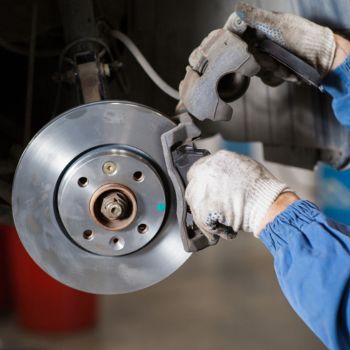 Brakes are built to stop a vehicle averaging about 4,000 pounds. Yet friction fuels this mechanism, which can lead to overheating and damage other system components. Learn how this happens and what you can do to prevent brakes from overheating.
Brakes are built to stop a vehicle averaging about 4,000 pounds. Yet friction fuels this mechanism, which can lead to overheating and damage other system components. Learn how this happens and what you can do to prevent brakes from overheating.
How Your Brakes Work
Today, the typical passenger car has a set of disc brakes. A solid, ventilated, cross-drilled or slotted disc is located right below the wheels, held in place by a set of brake pads, and pistons apply pressure to the pads. Brake fluid helps the pads move.
The clamping mechanism applied to the discs creates a significant amount of friction and heat, much of it absorbed by the discs and pads. The brake fluid helps divert some of the heat or it will pass through a ventilated or slotted disc.
Causes of Overheating Brakes
Overheating often results from older, worn-out components or parts that don’t fit together. Causes include:
- Damaged brake pads. Excess wear causes other system components to rub against each other and generate more heat.
- Poorly aligned components. If the brake pads or shoes don’t line up with other brake system components, pressure is applied in varying degrees, which can accelerate wear for these parts or the rotors.
- The pads haven’t been bedded. When the brake pads are not paired with used rotors and tested ahead of time, they don’t perform as expected and may overheat.
- Your brakes can’t cool down. Brakes that are constantly hot cause the fluid to boil. As the fluid can’t property transfer heat, this cycle repeats. Air bubbles also start to form in the brake fluid, which result in a spongy sensation and more force applied to stop the car.
- Water in the brake fluid. Similar to other fluids in your car, brake fluid draws in water with time. Higher amounts decrease its boiling point, which causes your brakes to overheat sooner.
- Glazed or melted brake pads. Due to excessive heat exposure, the binders on the brake pad start to melt off, which decreases friction, creates a lubrication effect and slippery deposits on the rest of the system. This decreases stopping power and requires more pressure.
Signs of an Overheating Brake System
Your brake system may be overheating if you notice one or more of the following signs:
- The brake light comes on.
- You hear a squeaky or creaky sound when applying pressure – a signed of glazed brakes or a worn brake lining.
- A soft or spongy sensation when you apply pressure, also known as brake fluid fade, and a sign this liquid has absorbed too much water.
- A burning smell as you apply your brakes, which indicates parts are stuck, corroded or generating high amounts of dust.
What to Do
At the first sign of overheating brakes, avoid driving. You risk brake failure or having the system catch fire. At this point:
- Pull over, so that you’re away from other vehicles.
- See if your vehicle can be rolled to a gradual stop.
- Once your car has stopped, apply the parking brake, which causes the disc brakes to separate from the rotor and helps them cool down.
- While you can attempt to drive once the brakes fully cool, make a service appointment as soon as possible to have the system inspected.
- If your car does not seem safe to drive, consider having it towed.
To prevent overheating in the future:
- Only apply gradual, light pressure to stop your vehicle.
- Avoid riding the brake as you drive down hills.
- Try engine braking, when you reduce pressure on the accelerator to slow down.
Concerned about your car’s brake system? Make an appointment with DaSilva’s Auto Body for an inspection and to have any fluids or parts replaced. To learn more, contact us today.




